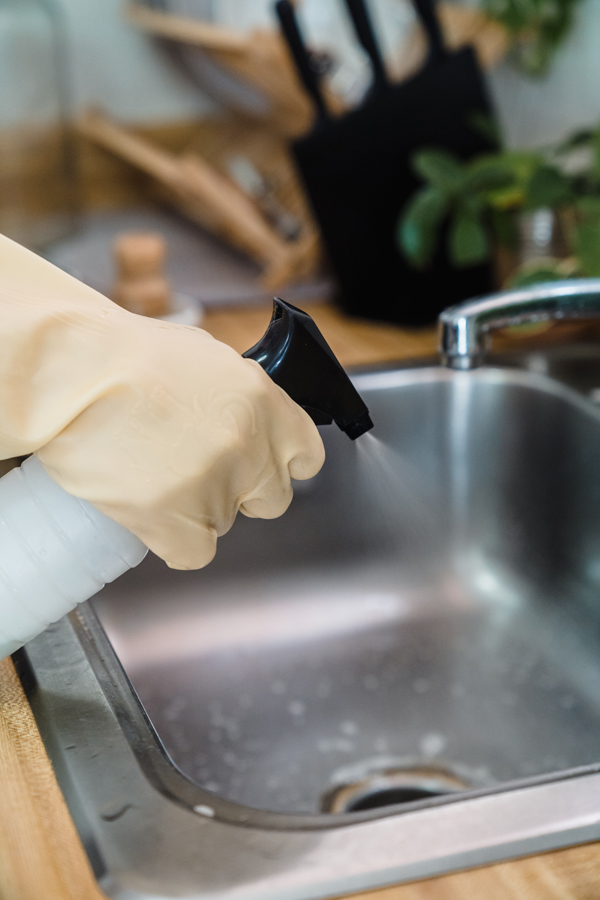Tips for cleaning your sink, stain removal, scratches and more.
Cleaning Faucets
Chrome faucets are easily cleaned with soapy water. Rinse and wipe dry with a paper towel to restore luster. An old toothbrush helps get deposits of dirt out from under edges of faucet. For hard-to-remove spots, use silver polish, rinse, and wipe dry.
Cleaning Fiberglass Sinks and Tubs
Use non-abrasive cleaners such as:
hand dishwashing liquids or liquid laundry detergents .
household all-purpose cleaners or bathroom cleaners (i.e. “409”, “Dow Bathroom Cleaner”, etc.)
mild to moderate alkali solutions (i.e. baking soda in warm water, trisodium phosphate in warm water
(1 tablespoon per gallon, “Spic & Span” solution which contains trisodium phosphate, etc.)
baking soda moistened with water to a paste; wet surface of tub or stall; gently rub with the paste on a sponge, or soft nylon brush.
Apply all cleaners with a sponge or non-abrasive applicator made of nylon, polyester, or polyethylene. Rub gently. Always rinse thoroughly to remove all cleaner.
Never use any abrasive cleaner like common scouring powders, nor any abrasive scouring pads, steel wool, and paper, or scrapers.
Porcelain Enamel Sinks and Tubs – Care and Cleaning
Care
Porcelain enamel is a glass surface fused to a metal base.
This glass surface is damaged by acids and harsh abrasives. It is very hard but can be chipped by hard blows.
Porcelain enamel is acid resistant but not acidproof. The glass coating is gradually dissolved by acids. Acetic and muriatic acids are effective in removing certain stains, but they will also remove part of the surface coating of porcelain enamel. Eventually they will attack the base metal underneath and cause serious damage. Therefore, it is advisable not to use acid cleaners on porcelain enamel.
Cleaning
To clean, wash with warm or hot sudsy water, using detergent. A solution of non-precipitating water softener, or baking soda, in warm water also may remove soap scum and soil. Always rinse with plain water.
If you use scouring powder it should be the very finest one possible. Most scouring powders contain hard particles, such as quartz or feldspar, that cause minute scratches. Once a glasslike surface has been roughened, it becomes a catchall for dirt, grease, soap residue and minute alkaline deposits from hard water. Then abrasives are necessary to remove soil imbedded in the roughened area.
Commercial household or bathroom cleaners may also be used.
You may use chlorine or hydrogen peroxide bleach to remove stains. Do not use these bleaches full strength or let them remain on the surface for more than a few seconds. Rinse the surface thoroughly. Bleaches eliminate most stains but are not effective on rust.
Heavy deposits of grease or soap scum can be removed with a solution of 1 tablespoon trisodium phosphate in 1 gallon hot water. Rinse thoroughly. Or warm water and ammonia solution will do this. Rinse thoroughly. Do NOT combine with any other cleaners.
Removing Lime Deposits on Bathroom Fixtures
Regular cleaning can prevent buildup of staining material. Repair leaking, dripping faucets to stop staining.
Lime or hard-water mineral buildup is dissolved by an acid. Vinegar or lemon juice may be rubbed over the stain, to dissolve. Do not leave on stain too long, as acids will eventually damage surface of porcelain enamel. Rinse thoroughly. Commercial products designed to remove lime deposit may be used if label says safe for the surface. Do not use acids on fiberglass, nor any commercial product unless label says safe for fiberglass.
The Author:
Anne Field, Extension Specialist, with credit to MSU Extension

Freshen Sinks – Use equal parts table salt (mild abrasive), baking soda (kills odors) and vinegar. Clean the sink with the mixed ingredients then rinse with boiling hot water.
Wow, this is such a helpful tip! I’ve never thought of using a mixture of table salt, baking soda, and vinegar to freshen up my sink. It’s great to know that these common household ingredients can also act as a mild abrasive and odor killer. I’ll definitely give this method a try and see how it works for me. Thanks for sharing this awesome hack!
Clogged Sink – Before you buy a drain-o type product try this…
1. Put a generous amount of baking soda down the clogged drain.
2. Pour a generous amount of white vinegar (remember the volcanoes you made it elementary science projects? – this will be like that)
4. Wait for about 10-15 minutes
5. Flush with hot water
This usually works for me. On a really stubborn clog, you might want to repeat the process.
Thanks for sharing this alternative method for clearing blocked sinks. It’s always good to have different options to try.
To clear blocked sinks dissolve 3 fizzy indigestion tablets in a cup of vinegar, pour down sink and leave for an hour or so….this will clear most minor blockages.
Great tip! I never thought about using fizzy indigestion tablets to clear blockages in the sink. I’ll definitely give it a try next time I have a minor blockage.